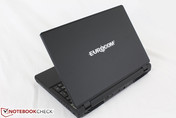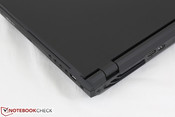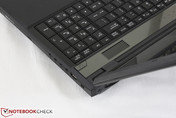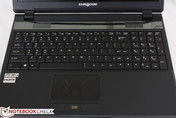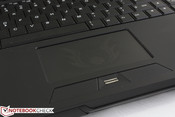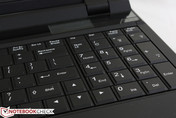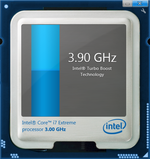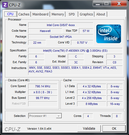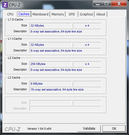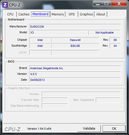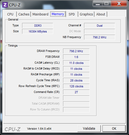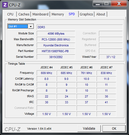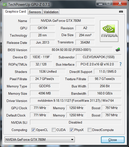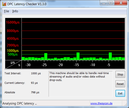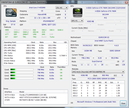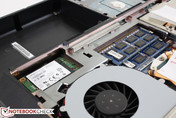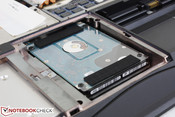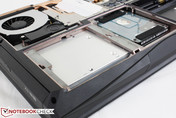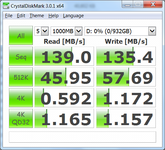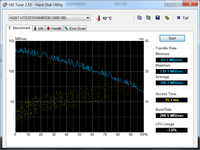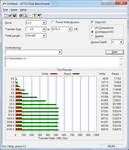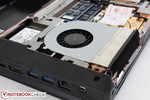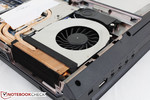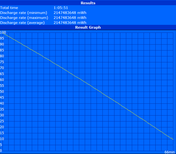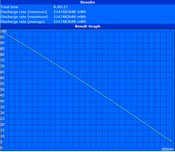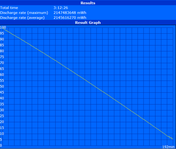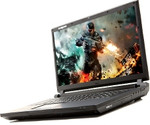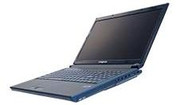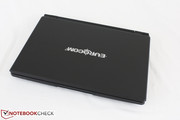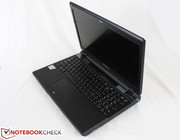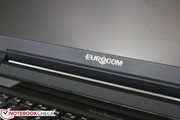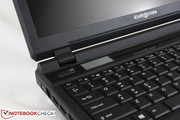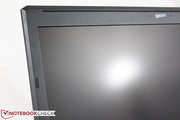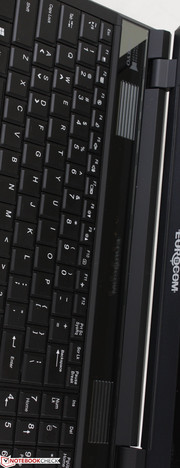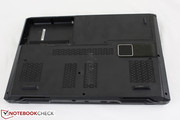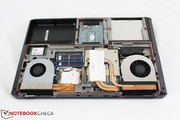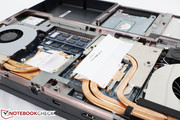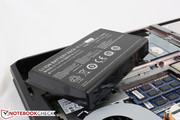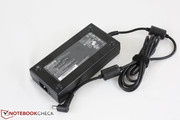Review Eurocom X3 (Clevo P157SM) Notebook

Our last scrutiny on a Eurocom model was the 15.6-inch Racer 2.0 based on the Clevo P150EM barebones late last year. Equipped with AMD’s top of the line Pitcairn GPU, the entire package had a shaky launch due to a few Radeon driver issues, but the hardware itself was nonetheless impressive on its own right. Eurocom’s updated lineup this year coincides with the launch of both Haswell and Nvidia's Kepler refresh and, as is typical for a high-end reseller, includes some of the most powerful silicon from both manufacturers.
The Eurocom X3 is similar in size to the Racer 2.0, but makes use of a newer Clevo P157SM barebones housing a more powerful Core i7-4930MX quad-core CPU paired with both 16 GB RAM and a GeForce GTX 780M GPU. We reviewed the chassis in great detail earlier this month equipped with a different set of hardware features, but it was only a pre-production model due to limited availability. Since the Eurocom X3 shares many hardware similarities, we focus instead on the hardware performance benefits that this newer model provides compared to the Racer 2.0 and other DTRs equipped with first generation Kepler GPUs. For more information on the case, connectivity and input devices, please see our review on the preliminary K56-3N2 model.
Case
Compared to our pre-production K56-3N2 unit, the final Eurocom model sports the same high quality construction and rubberized surfaces for a more luxury feel than the Clevo P150EM. Other minute upgrades include sharper-looking edges and corners and more stylized vent grilles that remind us of the slick Asus ROG notebooks. Certain areas that do not have the new rubberized surface treatment, such as the inner display bezel, side edges and belly, feel rigid nonetheless with little to negligible warping under applied pressure. It’s still a boxy chassis compared to the heavy stylized Maingear or Alienware notebooks, but that is to be expected from a barebones unit made for easy end-user maintenance and troubleshooting.
One minor complaint is the new rectangular speaker grilles that look rather lackluster in design. Both grilles are also protected by slits of glossy covering, which are thin enough to bend when pressed. Compared to sleeker speaker designs as found on many MSI-based barebones, the speakers here appear much more unremarkable. Fortunately, the wobbly display that we experienced on the K56-3N2 is much less severe on the Eurocom equivalent. The small hinges are very stiff with no noticeable screen vibrations whilst typing on a solid surface.
Input Devices
Keyboard
The differences between keyboards on Clevo barebones are minor as most are beveled with raised rectangular keys and have a similar layout and overall feel. We especially like that the left- and right-hand edges of the backlit keyboard are close to the sides of the notebook for additional space. The directional keys, for example, are thankfully the same size as the QWERTY keys, but the Enter key could be a bit too small for some. Travel also feels shallow for a DTR, though this is made up for by the solid yet quiet feedback of the keys.
Touchpad
Whereas the keyboard has remained relatively unchanged compared to the Racer 2.0, the lightly rubberized touchpad (10 cm x 6 cm) and click keys have been slightly redesigned with a less boxy look. The touchpad itself is smooth and responsive with no warping if pressed firmly. The click keys are similar, but with a shallower travel than what one may expect from a thick notebook. Also noteworthy is the auditory click, which is different in tone between the left and right keys. Feedback is satisfactory all around, though we would have liked a deeper travel for the keys in general.
Display
The 1080p display is nothing short of amazing and in fact uses the same Lenovo B156HW01 V4 panel as found on the high-end MSI MS-16F2 barebones and ThinkPad W530 workstation. Subjectively, texts are crisp, colors look deep and the screen is free from the screen door effect that can often be found on budget notebooks.
An X-Rite i1Pro Basic 2 was used to directly measure screen brightness across nine quadrants. With an average of about 242 nits, the display nearly matches and essentially confirms our measurements on the similar One K56-3N2 notebook. For a matte display meant mainly for indoor use, this maximum brightness is sufficient for comfortable viewing, though many Ultrabooks do have much higher brightness levels in order to improve outdoor visibility. Compared to other gaming notebooks, the original Racer 2.0 is only slightly dimmer while the recently released 17.3-inch MSI GT70H is much brighter at over 300 nits.
| |||||||||||||||||||||||||
Brightness Distribution: 87 %
Center on Battery: 260.1 cd/m²
Contrast: 591:1 (Black: 0.44 cd/m²)
88.8% AdobeRGB 1998 (Argyll 3D)
97.2% sRGB (Argyll 3D)
80.9% Display P3 (Argyll 3D)
Gamma: 2.4
CCT: 6608 K
Color space reproduction nearly covers the AdobeRGB standard at about 95 percent. This is very similar to the display of the Eurocom Racer 2.0, rivals that of the similar ThinkPad W530 and is much wider than the gaming-centrc MSI GT70H, which makes the Eurocom a better choice for professional digital artists.
Further display analyses were performed with the CALMAN 5 software. When out-of-the-box and uncalibrated, the Eurocom was already able to show good color and gamma levels, though the overly cool color temperature threw off a bit of the display’s accuracy. Results post calibration with the X-Rite i1Display 2 lowered the color temperature to a much more reasonable 6580K for both a more accurate grayscale and saturated color reproduction.
Outdoor use is, of course, not recommended with a DTR. If unavoidable, the X3 can be used rather comfortably when under shade on a flat surface and at maximum screen brightness. Battery life is expected to take a large hit under these conditions and its large power adapter should definitely be within reach throughout the day. Fortunately, maximum brightness will not artificially drop if running on batteries.
Viewing angle stability is wider than budget TN displays with much less intense color inversions at lower angles. Viewing at an angle below the center normal still suffers from major color shifting due to the inherent panel technology as IPS panel options are still a rarity in this class of high-end DTRs.
Performance
The launch of the Eurocom X3 comes just in time after the arrival of both Intel’s Haswell and Nvidia’s Kepler refresh. As a result, the notebook houses some of the most high-end hardware options for a 15.6-inch DTR including a Core i7-4700MQ, i7-4800MQ, i7-4900MQ and i7-4930MX CPU options with an Nvidia GTX 765M, GTX 770M or GTX 780M. Whereas Haswell represents significant on-die changes from its previous “tock” generation, the GeForce 700M series is a simple rebrand before the inevitable Maxwell successor. More information on the Haswell architecture can be found in our full review here.
The model in review houses the top models from both sets: the i7-4930MX and GTX 780M rated at 3.0 GHz and 823/1250 MHz core/memory, respectively. In the X3, this CPU will idle at 800 MHz (similar to IVB cores) and the GPU at 135/162 MHz for power-saving purposes. Optimus is included alongside the integrated Intel HD 4600 GPU, but all performance benchmarks below will focus on the discrete Nvidia solution instead. More information on the HD 4600 can be found in our full review here.
RAM is provided by four 4 GB PC3-12800 removable modules, all of which are accessible via an easily removable hatch below the notebook and underneath the keyboard. More pictures of the internals can be seen in our review of the K56-3N2.
A quick run with DPC Latency Checker returned no recurring high latency peaks. This is perhaps unsurprising considering that Eurocom products are usually installed with clean operating systems; a separate disc with drivers is provided for manual installation of auxiliary features and functions.
Processor
Performance from the i7-4930MX CPU is similar to that of the desktop Ivy Bridge i7-3770K in CineBench benchmarks. Compared to mobile processors, the CPU is similar to the i7-3940XM, the fastest quad-core Ivy Bridge processor currently available. This is to be expected as both cores share the same Turbo Boost clock rates and L1 through L3 cache sizes. Despite the architectural improvements, however, the Haswell core in the X3 shows only small benchmark performance benefits when compared directly to the i7-3940XM. Multi-thread wPrime results in particular are slower for the i7-4930MX than the i7-3940MX (240 seconds vs. 219 seconds) while Super Pi and CineBench R10 results are only slightly better.
System Performance
PCMark 7 and PCMark Vantage were used to assess system performance. At 6053 and 21909 points, respectively, the X3 outclasses the recently reviewed MSI GT70H (5310 points) and the Acer Aspire S5-391 (5949 points) with 2x Lite-On SSDs in RAID 0 formation. The latter is worth mentioning as PCMark 7 tends to favor systems with dedicated SSDs over mechanical drives, and the Eurocom still comes out on top with only a single SSD. We have tested very few notebooks that were able to crack the 6000 mark in PCMark 7 - the Dell Precision M6700 and Schenker XMG P703 being the most notable. Anything above this range speaks volumes about general application performance and system responsiveness.
| PCMark Vantage Result | 21909 points | |
| PCMark 7 Score | 6053 points | |
Help | ||
Storage Devices
The X3 is capable of housing up to five internal drives: 2x 7mm or 9.5 mm SATA III drives, 2x mSATA SATA III drives and 1x ODD SATA II drive with RAID 0/1/5/10 support. This alone is impressive for a 15.6-inch barebones where up to two or three simultaneous drives are much more common. Due to space constraints, the second mSATA bay is hidden underneath the first HDD bay while the second HDD bay is hidden underneath the ODD SATA II drive. Note that an optical drive occupies the ODD bay by default and must be swapped out in order to insert a hard drive.
Our review model is equipped with two drives: a primary mSATA 120 GB Crucial CT120M500SSD3 and a secondary 7200 RPM 1 TB Hitachi Travelstar HGST HTS721010A9E630. Both drives return very fast benchmark numbers; the HDD in particular averages 106.7 MB/s transfer rates on HD Tune, which is one of the fastest 9.5 mm 1 TB drives we have tested.
Similarly, the Crucial SSD is near the top of the list in terms of sequential read speed alongside the high-end Lite-On LMT-128M3M and ADATA XM11. Sequential write speeds (137.5 MB/s) could be a bit better as many Samsung and Intel 320/520 Series of SSDs return slightly higher numbers in Crystal Disk Mark, though real-world performance will be subjectively similar. The ability to easily enable RAID 1 between the already superfast SSDs or HDDs will surely appeal to power users.
For more benchmarks and comparisons between HDD and SSD models, see our growing list here.
Gaming Performance
Compared to the previous GTX 680M record holder, the GTX 780M crams in more unified shaders (1536 cores vs. 1344 cores) operating at higher maximum frequencies (823 MHz vs. 720 MHz) with GPU Boost 2.0. Even though the core architecture remains essentially identical, performance in both synthetic benchmarks and games has increased noticeably.
3DMark Fire Strike Extreme returns a final score of 2344 points, almost 20 percent higher than the iBuyPower Valkyrie CZ-17 with its GTX 680M under the same benchmark. Similarly, final 3DMark 11 scores for the X3 are over 25 percent higher over the Valkyrie (7900 vs. 5804 points). A dedicated desktop GTX 680 or systems with dual GTX 680M graphics like the Clevo P370EM still come out substantially higher (9946 points and 9255 points in 3DMark 11, respectively), but the GTX 780M is so far unmatched for a single consumer-oriented mobile GPU setup.
Gaming performance is equally remarkable; all games tested can be played smoothly on High or Ultra settings at 1080p resolution. Even Guild Wars 2 and its bandwidth-heavy supersampling AA was not enough to substantially cut down frame rates, which was a smooth 50 FPS compared to 34 FPS on the 680M-equipped Valkyrie CZ-17 and 32 FPS on the Radeon HD 7970M-equipped XMG P502. Certain titles like Sleeping Dogs, Crysis 3 or the Metro 2033 series utilize more advanced display techniques than other games and will run closer to 30 FPS on average at maximum settings. It’s certainly outstanding for a simple Kepler refresh at the cost of high fan noise as detailed in the next section.
For more information, comparisons and benchmarks on the GTX 780M, see our full review of the GPU here.
| 3DMark 06 Standard Score | 27795 points | |
| 3DMark Vantage P Result | 27543 points | |
| 3DMark 11 Performance | 7900 points | |
| 3DMark Ice Storm Standard Score | 88679 points | |
| 3DMark Cloud Gate Standard Score | 19208 points | |
| 3DMark Fire Strike Score | 4786 points | |
| 3DMark Fire Strike Extreme Score | 2344 points | |
Help | ||
| low | med. | high | ultra | |
|---|---|---|---|---|
| Deus Ex Human Revolution (2011) | 233 | 108 | ||
| The Elder Scrolls V: Skyrim (2011) | 94 | 66 | ||
| Sleeping Dogs (2012) | 102 | 31 | ||
| Guild Wars 2 (2012) | 57 | 50 | ||
| Dishonored (2012) | 128 | 126 | ||
| Call of Duty: Black Ops 2 (2012) | 170 | 106 | ||
| Tomb Raider (2013) | 155 | 66 | ||
| StarCraft II: Heart of the Swarm (2013) | 110 | 74 | ||
| BioShock Infinite (2013) | 150 | 46 | ||
| Metro: Last Light (2013) | 70 | 37 |
Emissions
System Noise
The X3 utilizes two discrete system fans - one larger 60 mm GPU fan and a smaller 45 mm CPU fan – each with their own rear exhaust vent. Certain barebones only utilize a single fan and connected heatsink assembly, such as the MSI-based Maingear Nomad 15, with varying results.
When idling, the Eurocom can be as low as 33.7 dB(A), which is only noticeably audible under quiet ambient conditions. This is impressive considering the horsepower inside, but system noise will easily bump up to the very audible 40 dB(A) range under even very light loads and will remain steady at this noise level.
Medium to high workloads will increase fan noise to 45.3 dB(A) and 52.8 dB(A) if the discrete GPU is under stress or gaming. If left under maximum stress, a high of 57.4 dB(A) was measured from the system, or louder than similarly sized systems like the Racer 2.0, MSI GT60 or Nomad 15. Generally, users can expect unavoidable fan noise during use, which is common amongst DTRs.
Noise Level
| Idle |
| 33.7 / 33.8 / 33.9 dB(A) |
| DVD |
| 44.4 / 45.8 dB(A) |
| Load |
| 41.1 / 57.4 dB(A) |
 | ||
30 dB silent 40 dB(A) audible 50 dB(A) loud |
||
min: | ||
Temperature
Surface temperatures on the X3 remain reasonably low ranging from low to mid 30 degrees C when idling or under light loads. While this may be partly attributed to the somewhat loud system fans, this also ensures comfortable hands during everyday use. The usual rear hot spots are almost not identifiable under these conditions as well. The palm rests in particular do not change much at all in terms of surface temperatures even when under higher loads, likely due to the design choice of exhausting almost all heat through the rear only and positioning the copper heat pipes further away from the front.
When stressed under maximum CPU and GPU loads for over an hour, clear hot spots can be easily recognized. The bottom corner closest to the GPU was as hot as 55 degrees C according to our measurements, or a full 10 degrees warmer than the corresponding CPU side and its smaller fan and heatsink assembly. Overall temperatures here are much higher than the similar K56-3N2 and Ivy Bridge/Radeon equipped Racer 2.0 notebooks, but most users will never experience such high levels as our test is generally unrepresentative of everyday or even gaming use.
(-) The maximum temperature on the upper side is 45.8 °C / 114 F, compared to the average of 40.5 °C / 105 F, ranging from 21.2 to 68.8 °C for the class Gaming.
(-) The bottom heats up to a maximum of 55 °C / 131 F, compared to the average of 43.3 °C / 110 F
(±) In idle usage, the average temperature for the upper side is 32.1 °C / 90 F, compared to the device average of 33.9 °C / 93 F.
(±) The palmrests and touchpad can get very hot to the touch with a maximum of 38.2 °C / 100.8 F.
(-) The average temperature of the palmrest area of similar devices was 28.9 °C / 84 F (-9.3 °C / -16.8 F).
Stress Test
We utilize Prime95 and FurMark to stress the CPU and discrete GPU, respectively, with CPU-Z, GPU-Z and HWiNFO monitoring tools. With only Prime95 active, the CPU cores were observed to be operating at a steady 3.3 to 3.5 GHz range with no drops or sudden throttles. Note that this range is below the rated 3.7 GHz maximum Turbo Boost for all active cores, but still around 300 to 500 MHz faster than its base 3.0 GHz clock rate. Core temperatures also rose very quickly to over 85 degrees C within the first 10 seconds accompanied by an increasingly louder system fan.
With only FurMark active, the GTX 780M was observed to be operating at its 770.8 MHz core clock, but slowly dropped to a more stable 692.4 MHz. Memory clock remained steady at 1250 MHz throughout while GPU temperature hovered close to 80 degrees C.
With both Prime95 and FurMark active simultaneously for over an hour, the CPU clocked a bit lower at a steady 3.2 to 3.4 GHz while the GPU was able to operate at a steady 692.4 MHz throughout the entire duration. CPU and GPU temperatures reached a very hot but expected 94 and 87 degrees C maximum, respectively, by the end of the test. Neither processing cores were observed to throttle, though users should keep in mind that the high 94 degrees temperature is quite close to the 100 degrees thermal operating limit of the Haswell processor. A quick 3DMark 11 run immediately following the stress test returned no reductions in both final and CPU scores, which confirm no throttling issues for even intense everyday workloads.
If running on batteries, both CPU and GPU performances drop significantly, even when running on the High Performance profile. The CPU operates only up to 1.8 GHz for all cores while the GPU similarly maxes out at 405/400 MHz. A 3DMark 06 run on batteries returned much lower numbers with a final score of 14027 points and 3780 points for the CPU. These scores are essentially halved compared to an available AC supply, which returned 27795 points and 7119 points in the same test.
Speakers
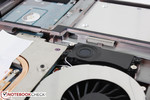
The 2.2 W stereo speakers plus 2.5 W subwoofer sound great and are similar in size to the Racer 2.0, but underwhelm for the price and when compared to the competition. Like our pre-production review model, sound quality has a slight tinny attribute despite the active subwoofer. The X3 speakers do perform better at louder volumes compared to other notebooks of the same size where unbalanced sounds, static or rattling may occur due to unwanted vibrations.
Battery Life
Like the Racer 2.0 and K56-3N2, the Eurocom X3 comes with a dense 8-cell 5200 mAh 76.96 Whr battery and no other available capacities. Performing the same Reader’s Test and Classic Test as on the K56-3N2 returned similar runtimes as expected, if not slightly lower overall. When under general WLAN use with the occasional videos at 150 cd/m2 brightness, users can expect a solid 3 hours of runtime before needing to shutdown. Enabling the dGPU can potentially knock battery life down by almost 2 hours if under heavy processing loads.
Average runtime on the X3 compares favorably against the Pitcairn-based Racer 2.0 and is more or less comparable to the similarly specced Clevo P150SM. The Nomad 15 and its high-end IVB and GTX 680M components managed to last about an hour longer under the same WLAN test. Generally speaking, we have yet to record significantly longer battery life advantages from mobile Haswell and high-end GTX 700M systems, so users should still expect similar runtimes compared to barebones with previous generation hardware.
Verdict
We can spend all day complaining about the size, fan noise and battery life of the Eurocom X3, but such qualities may not be exactly what the target audience is most concerned about. Raw performance is where it’s at and the X3 does its best to satiate eager performance-hunters in need of a 15.6-inch barebones model with a high-end Haswell-compatible chipset and an MXM 3.0 bay for an equally high-end GPU. Additional improvements, such as the ability to connect up to five internal storage drives and Eurocom’s 3-year warranty options may persuade users who might be considering more pre-baked solutions from DTR competitors and resellers like MSI, Alienware, or Maingear. Internally, the X3 is quite similar to the previous generation Racer 2.0 with slight modifications both inside and out for a sleeker feel without sacrificing case quality. This is certainly welcomed as Clevo barebones tend to lack the aggressive styling that said competitors above usually have and exploit.
A notable negative is the system’s reduced performance when running on batteries. Even when on high performance mode, both the CPU and GPU will operate at reduced speeds below their base frequencies. However, this will have no ill effects if word processing or browsing and we expect most users will have the notebook plugged to a nearby outlet regardless.
The second negative is the inability of this particular Haswell CPU to maintain its rated maximum 3.7 GHz Turbo Boost for all four active cores. Sustaining maximum Turbo Boost for any CPU is not easy for notebooks due to heat, stability issues, TDP limits or other power bottlenecks as many other high-end DTRs face the same issues. Still, the X3 was able to maintain 3.2 to 3.5 GHz Turbo Boost clock speeds without issues in our tests, handily above its base 3.0 GHz clock. The GPU would operate under its rated 770.8 MHz core clock too, but performance and benchmark numbers are nonetheless appreciably higher than much of the competition.
The Eurocom X3 and its related new Clevo shells are already a great start for the new Haswell and Kepler generation. None of the updates offer radical upgrades or surprising departures that the few enthusiasts may have been waiting for, but they are nonetheless an expected step up in terms of raw performance and numbers.
In Comparison
| StarCraft II: Heart of the Swarm | |
| 1920x1080 Ultra / Extreme AA:on (sort by value) | |
| Eurocom X3 | |
| Ibuypower Valkyrie CZ 17 | |
| 1366x768 High AA:on (sort by value) | |
| Eurocom X3 | |
| Ibuypower Valkyrie CZ 17 | |
| 1366x768 Medium (sort by value) | |
| Ibuypower Valkyrie CZ 17 | |
| Guild Wars 2 | |
| 1920x1080 All Maximum / On AA:FX (sort by value) | |
| Eurocom X3 | |
| Ibuypower Valkyrie CZ 17 | |
| Schenker XMG P502 | |
| 1366x768 Best Appearance Preset AA:FX (sort by value) | |
| Eurocom X3 | |
| Ibuypower Valkyrie CZ 17 | |
| Sleeping Dogs | |
| 1920x1080 Extreme Preset AA:Extreme (sort by value) | |
| Eurocom X3 | |
| Ibuypower Valkyrie CZ 17 | |
| SCHENKER XMG P722 Pro | |
| Schenker XMG P502 | |
| 1366x768 High Preset AA:High (sort by value) | |
| Eurocom X3 | |
| Ibuypower Valkyrie CZ 17 | |
| SCHENKER XMG P722 Pro | |
| 1366x768 Medium Preset AA:Normal (sort by value) | |
| Ibuypower Valkyrie CZ 17 | |
| SCHENKER XMG P722 Pro | |
| Tomb Raider | |
| 1920x1080 Ultra Preset AA:FX AF:16x (sort by value) | |
| Eurocom X3 | |
| Ibuypower Valkyrie CZ 17 | |
| 1366x768 High Preset AA:FX AF:8x (sort by value) | |
| Eurocom X3 | |
| Ibuypower Valkyrie CZ 17 | |
| 1366x768 Normal Preset AA:FX AF:4x (sort by value) | |
| Ibuypower Valkyrie CZ 17 | |
| BioShock Infinite | |
| 1920x1080 Ultra Preset, DX11 (DDOF) (sort by value) | |
| Eurocom X3 | |
| Ibuypower Valkyrie CZ 17 | |
| 1366x768 High Preset (sort by value) | |
| Eurocom X3 | |
| Ibuypower Valkyrie CZ 17 | |
| 1366x768 Medium Preset (sort by value) | |
| Ibuypower Valkyrie CZ 17 | |
| Deus Ex Human Revolution | |
| 1920x1080 DX11, Soft Shadows, SSAO High, DOF: High, Post Processing, Tessellation AA:ML AF:16x (sort by value) | |
| Eurocom X3 | |
| Ibuypower Valkyrie CZ 17 | |
| SCHENKER XMG P722 Pro | |
| 1366x768 DX11, Shadows, SSAO, DOF: Normal, Post Processing, Tessellation AA:Simple Edge AF:4x (sort by value) | |
| Eurocom X3 | |
| Ibuypower Valkyrie CZ 17 | |
| SCHENKER XMG P722 Pro | |
| The Elder Scrolls V: Skyrim | |
| 1920x1080 Ultra Preset AA:8x AF:16x (sort by value) | |
| Eurocom X3 | |
| Ibuypower Valkyrie CZ 17 | |
| SCHENKER XMG P722 Pro | |
| Schenker XMG P502 | |
| 1366x768 High Preset AA:8x AF:8x (sort by value) | |
| Eurocom X3 | |
| Ibuypower Valkyrie CZ 17 | |
| SCHENKER XMG P722 Pro | |
| 1366x768 Medium Preset AA:4x (sort by value) | |
| Ibuypower Valkyrie CZ 17 | |
| Call of Duty: Black Ops 2 | |
| 1920x1080 (Extra) High / On, FXAA AA:4xMS (sort by value) | |
| Eurocom X3 | |
| Ibuypower Valkyrie CZ 17 | |
| Schenker XMG P502 | |
| 1366x768 High / On, FXAA AA:2xMS (sort by value) | |
| Eurocom X3 | |
| Ibuypower Valkyrie CZ 17 | |
| 1366x768 Medium / Off (sort by value) | |
| Ibuypower Valkyrie CZ 17 | |




